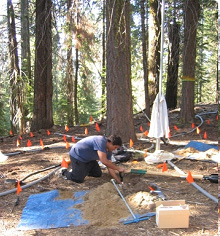The Geosciences Directorate of NSF funded 3 five-year grants (2007-2012) to emplace instrumentation and answer forefront questions at the cross-roads of hydrology, geomorphology, soil science, geophysics, ecology, and geochemistry. Implicit to the program goals was recognition of the contribution that earth scientists must make toward understanding the Critical Zone. The funded CZOs are (1) Southern Sierra, led by R. Bales (Univ. of CA Merced); (2) Boulder Creek, headed by S. Anderson (Univ. of Colorado), and (3) Susquehanna Shale Hills with C. Duffy (Pennsylvania State Univ.) as the lead PI. The 3 CZOs were each funded at $4.25 million largely from the Division of Earth Sciences (EAR) within NSF in the Geosciences Directorate. Uniquely, the CZOs are watersheds or groups of watersheds that are investigated by multi-disciplinary teams of geomorphologists, hydrologists, ecologists, soil scientists, and geochemists, using field, laboratory, and modeling approaches. The CZOs encourage outside collaborators to use the facilities with funding available in existing NSF programs. Such collaborations can be initiated at each CZO by contacting the principal investigator (PI) to use instrumentation and data.

As part of the Southern Sierra CZO, investigators of UC Davis (lead by J. W. Hopmans) deployed approximately 150 soil moisture sensors around a white fir is being used in concert with sap flow measurements in the trunk, and snow depth measurements to enable the SS CZO researchers to investigate how soil environmental stresses (water, temperature, nutrients) impact forest systems across the rainfall-to-snow-dominated transition zone.